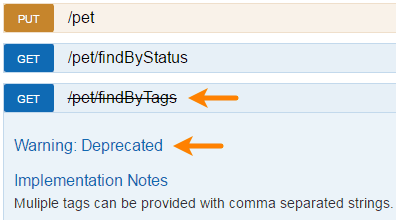路径和操作(Paths and Operations)
在Swagger术语中, paths 是API公开的端点(资源),例如/users或/reports/summary和 operations 是用于操纵这些路径的HTTP方法,例如作为GET,POST或DELETE。
路径(Paths)
API路径和操作在API规范的全局paths部分中定义。
paths:
/ping:
...
/users:
...
/users/{id}:
...所有路径都与basePath相关(请参阅API主机和基本URL)。完整请求URL构造为scheme://host/basePath/path。
路径模板(Path Templating)
Swagger支持路径模板,这意味着可以使用花括号{}将URL的部分标记为 路径参数:
/users/{id}
/organizations/{orgId}/members/{memberId}API客户端在进行API调用时需要提供适当的参数值,例如/users/5或/users/12。
操作(Operations)
对于每个路径,可以定义可用于访问该路径的操作(HTTP方法)。 Swagger 2.0支持get, post, put, patch, delete, head, 和 options。单个路径可以支持多个操作,例如GET /users来获取用户列表和POST /users来添加新用户,但是不允许为同一HTTP方法和路径执行多个操作。
最小例子:
paths:
/ping:
get:
responses:
200:
description: OK更详细的参数和响应模式示例:
paths:
/users/{id}:
get:
summary: Gets a user by ID.
description: >
A detailed description of the operation.
GitHub Flavored Markdown can be used for rich text representation,
such as **bold**, *italic* and [links](http://swagger.io).
operationId: getUsers
tags:
- users
produces:
- application/json
- application/xml
responses:
200:
description: OK
schema:
$ref: '#/definitions/User'
externalDocs:
url: http://api.example.com/docs/user-operations/
description: Learn more about User operations provided by this API.
definitions:
User:
type: object
properties:
id:
type: integer
name:
type: string
required:
- id
- name操作支持一些可选元素用于文档目的:
- 一个简短的
summary和一个更长的description操作。description可以是多行,并支持GitHub Flavored Markdown用于富文本表示。 tags用于在Swagger UI中对操作进行分组。- `externalDocs'允许引用和包含其他文档的外部资源。
操作参数(Operation Parameters)
Swagger支持通过路径,查询字符串,头和请求体传递的操作参数。有关详细信息,请参阅描述参数。
operationId
每个操作都可以指定一个唯一的“operationId”。一些代码生成器使用这个值来命名代码中的相应方法。
/users:
get:
operationId: getUsers
summary: Gets all users.
...
post:
operationId: addUser
summary: Adds a new user.
...
/user/{id}:
get:
operationId: getUserById
summary: Gets a user by user ID.
...路径查询字符串(Query String in Paths)
查询字符串参数 不能 包含在路径中。它们应该被定义为query parameters。
不正确的查询字符串:
paths:
/users?role={role}:正确的查询字符串:
paths:
/users:
get:
parameters:
- in: query
name: role
type: string
enum: [user, poweruser, admin]
required: false这也意味着不可能有多个路径仅在查询字符串中有所不同,例如:
GET /users?firstName=value&lastName=value GET /users?role=value
这是因为Swagger将唯一的操作视为路径和HTTP方法的组合,附加参数不会使操作唯一。相反,应该使用唯一的路径,如:
GET /users/findByName?firstName=value&lastName=value GET /users/findByRole?role=value
标记为已弃用
可以将特定操作标记为deprecated,以表明它们应该被转换为使用用法:
/pet/findByTags:
get:
deprecated: true工具可以以特定的方式处理已弃用的操作。例如,Swagger UI以不同的样式显示它们:
